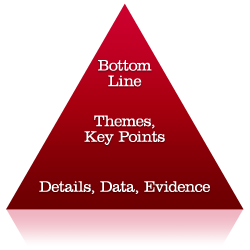Tender Writing: The Pyramid Principle & Logical Development
"The problem [with writing] is not so much to get the language right as to get the thinking clear"
KEY POINTS
- People think in patterns pyramids
- Think first, write later
- Pre-sorting your response into pyramids will maximise your impact
- Get the thinking clear and write as the reader thinks
- Consider using a skilled tender writer to edit and rewrite your drafts using the pyramid principle
Information presented in pyramid form is simpler to understand and easier to accept
People think in patterns
When we look up at the stars, we don't see individual lights, we sort them into patterns; the Southern Cross for example.
Barbara Minto (The Pyramid Principle) asserts that the structure in a reader's mind will always be a pyramid. If we want to have maximum impact on our reader's mind and make the ideas easier to comprehend, we need to deliver them pre-sorted into a pyramid shape.
Reading a novel for entertainment is the opposite of reading a report, memo or proposal. When we read a novel we are happy to be taken on a journey of unfolding mysteries, surprises and plot development. We progressively get introduced to characters, places and events until in the last page or two we are led to the story's conclusion or climax. Much like an upside down pyramid, where, as the plot develops, we are all led to a conclusion at the apex of the pyramid - "and they lived happily ever after". (See diagram below).

In contrast, the reader of a business document wants to start at the apex of the pyramid; getting to the bottom line in the shortest possible time. The rest of the document will amplify the key points and reasons for the stated conclusion. This supporting information is available for the reader if he wants to drill down further. (See diagram below).
Why a Pyramid?
When a person receives information - in our case a completed tender submission - he/she will read literally dozens if not hundreds of sentences. Each sentence must be digested, related to other information he has read and come together as a communication, message or knowledge.
Research tells us that the mind works to sort this information into distinctive pyramidal groupings in order to make sense of it. Knowing this means that if information is presented in a pyramidal form it will be simpler to understand, easier to accept. Barbara Minto states that every written document should be written to form a pyramid of ideas making it easier for the reader to digest.
The Pyramid Principle in Practice
An illustration: imagine you go to the shops to get the newspaper. As you're leaving the house your partner asks you to get some milk, grapes, potatoes, oranges, butter, apples, carrots and sour cream. Most would probably come back with the paper, milk and butter.
Why? The trick to remembering all of these items is to put them into logical groupings: dairy products (butter, milk, sour cream); fruit (grapes, oranges, apples); vegetables (potatoes, carrots). This is the mind sorting the information in to the most logical, easy to remember, groupings. Can you see the pyramid forming in your mind's eye?
In practice then, sorting ideas into pyramids means separating the thinking process from the writing process. It means sorting out your thinking before you begin to write.
The Pyramid Principle is divided into two sections. Part one explains this principle in detail and how to use it. In part two Minto shows how to apply the pyramid rules to improve the structure of your communication and how to think creatively so as to say precisely what you mean.
The Pyramid Principle is a must-read for the serious tender writer.
- 1. reduce the time it takes you to produce a first draft
- 2. increase your clarity and,
- 3. reduce the words you'll need to use to get your message across
 Robert Machin is a principal consultant for Tender Success and has assisted numerous organisations to improve the clarity & simplicity of their tender responses. Contact Rob to ensure your next response is a success.
Robert Machin is a principal consultant for Tender Success and has assisted numerous organisations to improve the clarity & simplicity of their tender responses. Contact Rob to ensure your next response is a success.




